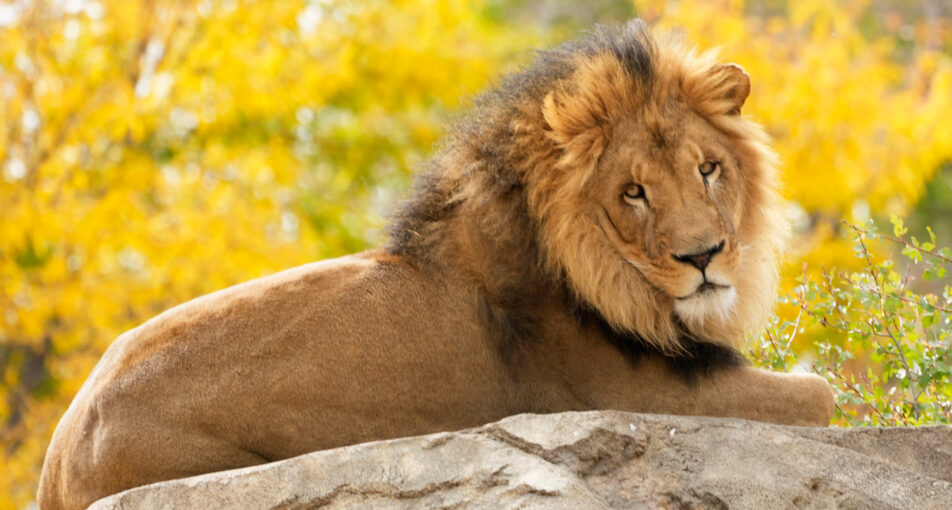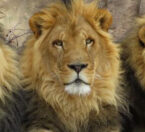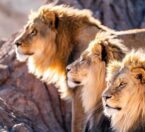Lions are the most social of all cats. They are the only cats that live in large family groups called “prides” consisting of four to 12 related adult females with their offspring plus two to three unrelated adult males. Lions also hunt in groups using stalking and ambush techniques. Females do most of the hunting. All members of the pride share in the kill, with males eating first followed by females and then cubs. Males protect the females and cubs from other lions and hyenas.
Classification
| CLASS: | Mammalia |
| ORDER: | Carnivora |
| FAMILY: | Felidae |
| GENUS: | Panthera |
| SPECIES: | leo |
Habitat & Range
African lions are typically found in savannas, plains, grasslands, dense bush and open woodlands where prey is abundant. They can also be found in smaller numbers in semidesert and mountain habitats.
This species can be found in most countries of sub-Saharan Africa, primarily inhabiting eastern and southern Africa up to elevations of 13,700 ft. (4,200 m).
Location


Adaptations
- Group social behavior allows for protection, success in raising offspring and ability to obtain food.
- Large manes make males look bigger which may intimidate rivals, attract females and protect their throat from another lion’s attack.
- Soft foot pads and retractable claws allow lions to move quietly when approaching prey. Lions have great forebody strength which enables them to bring down and hold prey sometimes with just a swipe of their larger front paws.
- Lions’ night vision is highly developed. Eyes see in very low light (1/6th the light humans need). A white circle below the eye reflects light also helping to see at night or early morning when lions tend to hunt.
- Lion’s sense of smell, although less important than its sight or hearing, helps when hunting, finding kills of other predators and identifying scent marking of territories.
- With relatively small hearts and lungs, when hunting lions rely on stalking prey and a short chase, reaching a top speed of about 35 mph (56 kph).
- Long tails have a black tuft of fur at the end used to communicate with each other on a group hunt and used by females to signal cubs to follow them. Lions are the only cats with a tufted tail.
- Lions are both an apex predator (top of the food chain) and a keystone predator (critical to the health of their ecosystem).
- Lions, like all big cats, can roar. Both males and females roar to communicate their territory and communicate with group members. The lion’s roar is the loudest of all big cats and can be heard up to 5 miles (8 km) away. Lions also roar the most of all big cats – sometimes considered habitual roarers.
Physical Description
- Lions are the second largest of the four big cat species (also includes tigers, leopards and jaguars). Lions are well-muscled with long bodies and large heads.
- Male average height at the shoulder is about 4 ft. (1.2 m), females about 3.5 ft (1.0 m). Body length ranges from 5.5 to 7 ft. (1.6 to 2.1 m) with tails 2 to 3 ft. long (0.6 to 1.0 m).
- Male weight ranges from 330 to 550 lbs. (150 to 250 kg), females 265 to 395 lbs. (120 to 180 kg).
- Fur of a lion is short and typically a tawny color, but also can be buff yellow, orange-brown, white-gray and dark brown. Underbody is white, also white around mouth, chin and inside of legs.
- Cubs have rosette spots which fade as they mature.
- Lions are the only cats with manes. The male’s mane, an example of sexual dimorphism (differences in appearance between males and females), can vary from a short fringe to full and shaggy covering the back of the head, neck, and on to the shoulders throat, chest and belly. In hotter, drier climates males may have no mane. Mane color ranges from blonde to black, typically darkening with age.
- Lions are digitigrade walkers (walk on toes). Soft paws are large with long, sharp, retractable claws measuring up to 1.5 in (38 mm) in length. Five toes on front (fifth is a dewclaw) and four on the back.
- Lions are visual animals (sight hunters). Amber eyes with round pupils are the largest of all carnivores.
- Lion tongues are covered in backward curving spines called papillae, used to scrape meat from bone and to groom themselves.
- Lions have a strong bite (690 lb. pressure compared to 171 lb. for humans). Incisor teeth grip and tear meat, canine teeth (largest) rip skin and tear away meat, carnassial teeth (sharpest) are used like scissors to cut meat. Jaws can hinge open to 11 in (28 cm) wide.
Diet
What Does It Eat?
In the wild:
As carnivores, African lions are specialized communal predators of medium- to large-sized ungulates. Typical prey includes antelopes, gazelle, warthogs, zebra, wildebeest and sometimes Cape buffalo, giraffe and young elephants. When prey is scarce, lions will consume almost any animal and scavenge off the kills of predators such as cheetahs or hyenas. In semi-arid habitats, they will also consume plants for water.
At the zoo:
Ground meat fortified with nutrients is fed five times a week. Once a week on a fast day, the lions are fed large bones. Also, once a week they are fed large carcass pieces of beef shank or rabbits. Sometimes on carcass day, a carcass piece up to 200 pounds is shared as a group followed by fasting for several days after.
What Eats It?
Humans hunt lions as trophies, for bushmeat and for body parts. Lions are also killed due to human conflict from increased agricultural development of wild habitats. The old and sick and very young lions not carefully watched by their mothers can be killed by hyenas, leopards and other predators.

Social Organization
Lions are social animals typically living in family groups called prides which can include up to three adult males and a dozen or so females and their young. However, prides up to 40 individuals have been recorded. All females in a pride are related and females will typically stay with their birth group as they age. Males leave their birth group around 2 years old when large enough to compete with the dominant male(s). These males will form small coalitions with other males, typically with their brothers. Coalitions hunt together and look for females to form their own pride, sometimes challenging the resident male in an established pride. In a pride, lionesses are the primary hunters and the males’ primary role is defending the pride and its territory. An individual male will dominate a pride for an average of 2.5 years when younger males aggressively displace him to gain access to pride females. Cubs are at the bottom of pride pecking order and the last to share in the kill.
Life Cycle
Lion average life span is 15 years but can live up to 30 years in human care. Lions breed year-round and are usually polygamous. While males are sexually mature at about 2 years, they are unlikely to breed until 4 or 5 years old. Females mature at around 3 years old. Gestation is about 108 days and litters are usually 2 to 4 cubs. Within a pride, females share parenting duties, including nursing each other’s cubs. Cubs weigh between 2 and 4 lbs. (.9 – 1.8 kg) at birth and are born blind and helpless with thick fur and dark spots that disappear as they age. Cubs are weaned at about 6 months but will eat meat starting at around 3 months.
















